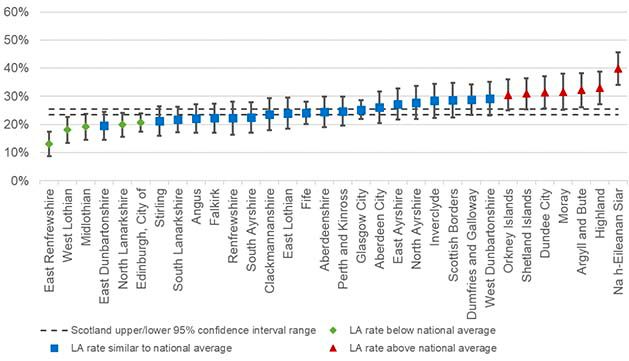Scottish House Condition Survey: Local Authority Analysis 2017-2019
Local Authority figures for 2017-2019, including fuel poverty rates, energy efficiency ratings, the condition of housing and the Scottish Housing Quality Standard.
This document is part of a collection
Fuel Poverty
Under the new definition[2], a household is in fuel poverty if, in order to maintain a satisfactory heating regime, total fuel costs necessary for the home are more than 10% of the household's adjusted net income (after housing costs), and if after deducting fuel costs, benefits received for a care need or disability and childcare costs, the household's remaining adjusted net income is insufficient to maintain an acceptable standard of living. The remaining adjusted net income must be at least 90% of the UK Minimum Income Standard to be considered an acceptable standard of living, with an additional amount added for households in remote rural, remote small town and island areas.
In the period 2017-2019, the fuel poverty rate varied from 13% in East Renfrewshire to 40% in Na h-Eileanan Siar compared to the average in Scotland of 24% (Figure 5).
Seven local authorities had significantly higher fuel poverty rates than the national average, these were: Na h-Eileanan Siar (40%), Highland (33%), Argyll and Bute (32%), Moray (32%), Dundee City (31%), Shetland Islands (31%) and Orkney Islands (31%). Five local authorities had significantly lower fuel poverty rates than the national average, these were: East Renfrewshire (13%), West Lothian (18%), Midlothian (19%), North Lanarkshire (20%) and City of Edinburgh (21%).

Note: In this chart, the fuel poverty rate for Scotland as a whole is a three-year average. This is different to the proportion published in the main SHCS Key Findings report, which is an annual figure. These are a best estimate of fuel poverty under the new definition of fuel poverty and therefore cannot be compared to statistics published under the old definition in local authority analyses prior to 2016-2018.
Contact
Email: shcs@gov.scot
There is a problem
Thanks for your feedback